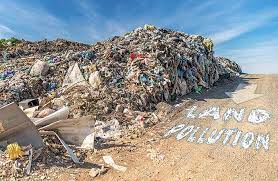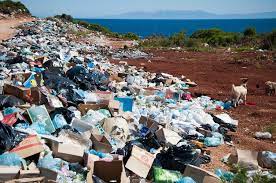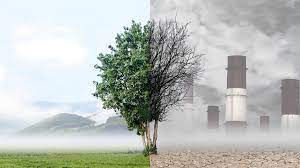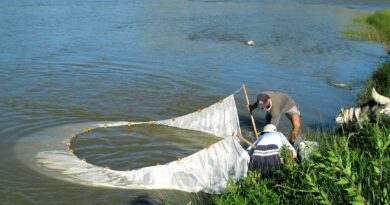Land Pollution, Causes, Effects and Solutions
Land pollution is the deposition of solid or liquid waste materials on land or underground in a manner that can contaminate the soil and groundwater, threaten public health, and cause unsightly conditions and nuisances.
The waste materials that cause land pollution are broadly classified as municipal solid waste (MSW, also called municipal refuse), construction and demolition (C&D) waste or debris, and hazardous waste.
MSW includes nonhazardous garbage, rubbish, and trash from homes, institutions (e.g., schools), commercial establishments, and industrial facilities.
Garbage contains moist and decomposable (biodegradable) food wastes (e.g., meat and vegetable scraps); rubbish comprises mostly dry materials such as paper, glass, textiles, and plastic objects; and trash includes bulky waste materials and objects that are not collected routinely for disposal (e.g., discarded mattresses, appliances, pieces of furniture).
C&D waste (or debris) includes wood and metal objects, wallboard, concrete rubble, asphalt, and other inert materials produced when structures are built, renovated, or demolished.
Read Also : Complete List of Recyclable Wastes (Waste Recyclables)
Hazardous wastes include harmful and dangerous substances generated primarily as liquids but also as solids, sludges, or gases by various chemical manufacturing companies, petroleum refineries, paper mills, smelters, machine shops, dry cleaners, automobile repair shops, and many other industries or commercial facilities.
In addition to improper disposal of MSW, C and D waste, and hazardous waste, contaminated effluent from subsurface sewage disposal (e.g., from septic tanks) can also be a cause of land pollution.
Cause of Land Pollution
1. Deforestation and soil erosion
Deforestation carried out to create drylands is one of the major concerns. Land that is once converted into dry or barren land will be difficult to be made fertile again.
Land conversion, meaning the alteration or modification of the original properties of the land to make it use- worthy for a specific purpose, is another major cause. It hampers the land immensely.
2. Agricultural activities
With the growing human population, the demand for food has increased considerably. Farmers often use highly toxic fertilizers (to supplement insufficient nutrients in the soil) and pesticides to get rid of insects, fungi and bacteria from their crops.
However, with the overuse of these chemicals, they result in contamination and poisoning of soil.
3. Mining activities
During extraction and mining activities, several land spaces are created beneath the surface. We constantly hear about land caving in, which is nothing but nature‘s way of filling the spaces left out after mining or extraction activity.
4. Overcrowded landfills
Each household produces tonnes of garbage each year. Garbage like aluminum, plastic, paper, cloth, wood is collected and sent to the local recycling unit. Items that cannot be recycled become a part of the landfills that hamper the beauty of the city and cause land pollution.
5. Industrialization
Due to an increase in demand for food, shelter, and house, more goods are produced. This has resulted in the creation of more waste that needs to be disposed of. In order to meet the demand of the growing population, more industries were developed, which led to deforestation.

Research and development paved the way for modern fertilizers and chemicals that were highly toxic and led to soil contamination.
6. Construction activities
Due to urbanization, a large number of construction activities are taking place, which has resulted in huge waste articles like wood, metal, bricks, plastic that can be seen by naked eyes outside any building or office which is under construction.
7. Nuclear waste
Nuclear plants can produce a huge amount of energy through nuclear fission and fusion. The leftover radioactive material contains harmful and toxic chemicals that can affect human health. They are dumped beneath the earth to avoid any casualty.
8. Sewage treatment
A large amount of solid waste is leftover once the sewage has been treated. The leftover material is then sent to the landfill site, which ends up polluting the environment.
9. Littering
Littering is a common problem, whether it is in a city or a rural area. People just throw their garbage on the ground without caring about the adverse effects on the environment.
A common instance is that people just throw their cigarette butt on the ground every time. Since cigarettes contain elements harmful to the environment, it leads to land contamination.
Effects of Land Pollution
1. Destruction of top soil
Soil pollution is another form of land pollution, where the upper layer of the soil or the topsoil‘s composition is damaged or becomes altered.
This is caused by the overuse of chemical fertilizers, soil erosion triggered by running water and other pest control measures, leading to loss of fertile land for agriculture, forest cover, fodder patches for grazing, etc. The regeneration process takes at least 500 years for 2.5 centimeters of topsoil.
2. Ground water poisoning
When harmful substances from industrial processes, chemicals are improperly disposed of on the land or in illegal landfills or storages, the chemicals and other substances could end up in the groundwater system.
The process is called leaching. It can happen on farms, industrial sites, and landfills and affect the health of animals, plants and also humans.
3. Drinking water problem
Drinking water is highly affected by land pollution. Nearly 50% of the world‘s population does not have access to safe drinking water, and each year water-based diseases cause up to 10 million deaths.
4. Change in climate patterns
The effects of land pollution are very hazardous and can lead to the loss of ecosystems altering balance of nature. When land is polluted, it directly or indirectly affects the climate patterns.
5. Environmental impact
When deforestation is committed, the tree cover is compromised. This leads to a steep imbalance in the rain cycle. A disturbed rain cycle affects a lot of factors.
Most importantly, the green cover is reduced. Trees and plants help balance the atmosphere; without them, we are subjected to various concerns like Global warming, the greenhouse effect, irregular rainfall and flash floods, among other imbalances.
6. Effect on human health
The land, when contaminated with toxic chemicals and pesticides, lead to potentially fatal problems like skin cancer and human respiratory ailments in particular. Globally, 9,500 people are diagnosed with skin cancer every day.
The toxic chemicals can reach our body through foods and vegetables that we eat as they are grown in polluted soil. Land pollution also caused developmental deficiency in children.
Chemicals, such as lead that are commonly found in contaminated soil and water, can impact a child‘s cognitive development even when the exposure is very low.
7. Effect on wildlife
The animal kingdom has suffered most in the past decades. They face a serious threat with regard to the loss of habitat and natural environment.
The constant human activity on land is leaving it polluted, forcing these species to move further away and adapt to new regions or die trying to adjust. Several species are also pushed to the verge of extinction, due to no homeland.
8. Waternutrient enrichment
Chemicals that are frequently used on agricultural farms, such as nitrogen, end up benefitting the crops only in a small proportion. The rest ends up in water populated by fish, algae, and other life forms.
As the nutrient-heavy water saps up most of the oxygen in the water, it leaves little oxygen for fish and other marine life. The water in that situation becomes unable to support most life forms.
9. Causes air pollution
Landfills across the city keep on growing due to an increase in waste and are later burned, which leads to air pollution. They become home for rodents, mice, etc., which in turn transmit diseases.
Control of Land Pollution
A number of ways have been suggested to curb the pollution rate. Attempts to clean up the environment require plenty of time and resources. Some the steps to reduce soil pollution according to Mishra et al. (2016) are:
Ban on use of plastic bags below 20microns thickness.
Recycling of plastic wastes.
Ban on deforestation.
Encouraging plantation programmes.
Encouraging social and agro forestry programmes.
Undertaking awareness programmes.
Reducing the use of chemical fertilizer and pesticides.
Recycling paper, plastics and other materials.
Ban on use of plastic bags, which are a major cause of pollution.
Reusing materials.
Suitable and safe disposal of wastes including nuclear wastes.
Chemical fertilizers and pesticides should be replaced by organic fertilizers and pesticides.
Encouraging social and agro forestry programs.
Undertaking many pollution awareness programs.
In summary, the effects of land pollution are very hazardous and can lead to the loss of ecosystems altering balance of nature.
The waste materials that cause land pollution are broadly classified as municipal solid waste (MSW, also called municipal refuse), construction and demolition (C and D) waste or debris, and hazardous waste.
Read Also : Complete List of Recyclable Wastes (Waste Recyclables)
Recycling paper, plastics and other materials is one of the ways to control land pollution.
Land pollution is the deposition of solid or liquid waste materials on land or underground in a manner that can contaminate the soil and groundwater, threaten public health etc.
The land, when contaminated with toxic chemicals and pesticides, lead to potentially fatal problems like skin cancer and human respiratory ailments in particular.
Chemical fertilizers and pesticides should be replaced by organic fertilizers and pesticides as a way of controlling land pollution.



